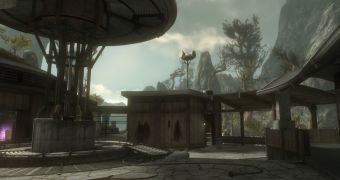Halo: Reach is the newest first person shooter from developer Bungie and publisher Microsoft, telling the story of how humanity lost the planet of Reach to the forces of the Covenant and how the actions of a few Spartans influenced the events of the first two games in the series.
Despite working with essentially the same game engine they have also used for Halo 3 Bungie managed to create some pretty impressive vistas in Reach.
The sky seems to have received the most attention from the developers and it really manages to evoke a beautiful world and suggest the dreadful things that will happen to all living things left on its surface in a few days.
But Bungie still seems in love with the spartan (no pun intended) style of buildings that they have first shown off in the first Halo game.
There it actually made sense to have the architecture feel completely alien and distant, with the action set on a Halo world and all of it created by the Forerunners, a race that had very powerful technology and presumably tastes in buildings and decorations that are very different from those of humans.
But Reach is almost as distant and cold as the environments of the previous titles, even if is supposed to be a human world which has been extensively colonized and turned into the most important center for industry apart from Earth itself.
Navigating the corridors, the bases, the courtyards it does not seem like people could ever live there or work there, mostly because the sense of scale is somehow twisted, seemingly designed to make it actually comfortable for the taller Covenant to occupy and then use the same structures.
The most beautiful constructs in Halo: Reach are those the aliens have put up in their landing zone, full of curves and intricate patterns, much more attractive than the sharp corners and dull grey or what humanity built.
The problem with the disconnect from the architecture is that it makes Reach harder to love as a player, which in turn lessens the impact of its destruction and limits some of the emotional message that Bungie aimed to package in its final Halo.

 14 DAY TRIAL //
14 DAY TRIAL //